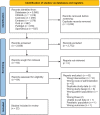The combined effects of manual therapy and exercise on pain and related disability for individuals with nonspecific neck pain: A systematic review with meta-analysis
- PMID: 37092822
- PMCID: PMC10642331
- DOI: 10.1080/10669817.2023.2202895
The combined effects of manual therapy and exercise on pain and related disability for individuals with nonspecific neck pain: A systematic review with meta-analysis
Abstract
Background: Neck pain is among the most prevalent and costly musculoskeletal disorders. Manual therapy and exercise are two standard treatment approaches to manage neck pain. In addition, clinical practice guidelines recommend a multi-modal approach, including both manual therapy and exercise for the treatment of neck pain; however, the specific effects of these combined interventions have not recently been reported in the literature.
Objective: To perform a systematic review and meta-analysis to determine the effect of manual therapy combined with exercise on pain, disability, and quality of life in individuals with nonspecific neck pain.
Design: Systematic Review and Meta-Analysis.
Methods: Electronic database searches were completed in PubMed, CINAHL, Cochrane, EMBASE, Ovid, and SportDiscus, with publication dates of January 2000 to December 2022. The risk of bias in the included articles was completed using the Revised Cochrane Risk of Bias Tool (RoB 2). Raw data were pooled using standardized mean differences and mean differences for pain, disability, and quality of life outcomes, and forest plots were computed in the meta-analysis.
Results: Twenty-two studies were included in the final review. With moderate certainty of evidence, three studies demonstrated no significant difference between manual therapy plus exercise and manual therapy alone in pain (SMD of -0.25 (95% CI: -0.52, 0.02)) or disability (-0.37 (95% CI: -0.92, 0.18)). With a low certainty of evidence, 16 studies demonstrated that manual therapy plus exercise is significantly better than exercise alone for reducing pain (-0.95 (95%CI: -1.38, -0.51)). Similarly, with low certainty of evidence, 13 studies demonstrated that manual therapy plus exercise is significantly better than exercise alone for reducing disability (-0.59 (95% CI: -0.90, -0.28)). Four studies demonstrated that manual therapy plus exercise is significantly better than a control intervention for reducing pain (moderate certainty) (-2.15 (95%CI: -3.58, -0.73)) and disability (low certainty) (-2.39 (95% CI: -3.80, -0.98)). With a high certainty of evidence, four studies demonstrated no significant difference between manual therapy plus exercise and exercise alone in quality of life (SMD of -0.02 (95% CI: -0.21, 0.18)).
Conclusion: Based on this systematic review and meta-analysis, a multi-modal treatment approach including exercise and manual therapy appears to provide similar effects as manual therapy alone, but is more effective than exercise alone or other interventions (control, placebo, 'conventional physical therapy', etc.) for the treatment of nonspecific neck pain and related disability. Some caution needs to be taken when interpreting these results given the general low to moderate certainty of the quality of the evidence.
Keywords: Neck pain; disability; exercise; manipulation; manual therapy; mobilization.
Conflict of interest statement
No potential conflict of interest was reported by the author(s).
Figures








References
-
- Blanpied PR, Gross AR, Elliott JM, et al. Neckpain: revision 2017. J Orthop Sports Phys Ther. 2017;47(7):A1–83. - PubMed
-
- Franke H, Franke J-D, Fryer G. Osteopathic manipulative treatment for chronic nonspecific neck pain: a systematic review and meta-analysis. Int J Osteopath Med. 2015;18(4):255–267.
Publication types
MeSH terms
LinkOut - more resources
Full Text Sources
